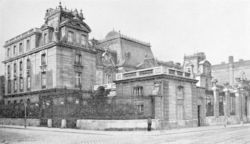Palais Rothschild, 24-26, Heugasse, Vienna, Austria
The Palais Albert Rothschild was a palatial house in Vienna, one of five Palais Rothschild in the city owned by members of the Rothschild family. It was located at Heugasse 26 (today Prinz-Eugen-Strasse 20-22), in the IVth (Wieden) district of Vienna. Commissioned by Albert von Rothschild, it was designed and built by the French architect Gabriel-Hippolyte Destailleur between 1876 and 1884, and demolished in 1954.
The building was unusual for Vienna. Designed in the French Neo-Renaissance “hôtel particulier” style, the layout was U-shaped, three storeys high and set back from the street by a courtyard, with the estate fenced off by a high iron grill. Attached to the palace was a garden which bordered on Plösslgasse. The entrance hall to the palace was dominated by an enormous marble staircase, the walls decorated with priceless gobelins, mirrors and paintings. The ballroom and various salons had ceilings painted by Jean de Witt and Tiepolo, and were richly decorated with stucco, gold leaf, and heavy hanging crystal chandeliers. The ornate parquet floors were made with expensive rare woods; the furniture was in the style of Louis-Seize. A special feature was a large orchestrion, built into a niche between the ballroom and one of the salons; together with a smaller orchestrion, these two instruments could replace an entire orchestra. In addition to being a private residence Albert used it to conduct his banking business. An unusual element of the building was the private observatory, located in the middle projection at the highest point of the palace, reached by a small wooden staircase beginning from the second floor, and fitted with numerous telescopes for viewing the stars.
Albert’s son, Louis Nathaniel von Rothschild (1882-1955), inherited the house when Albert died in 1911.
The Second World War
After the annexation of Austria by Nazi Germany, the Rothschild family was forced to flee and went into exile. Choosing to remain in Austria, after the Anschluß of Austria to Nazi Germany in March 1938, Louis von Rothschild he was arrested and later held under house arrest. His property and assets were placed under control of a German ‘commissioner’ while the German government attempted to expropriate his business concerns and personal fortune. Louis was released only after lengthy negotiations between the family and the Nazis and upon payment of $21,000,000, believed to have been the largest bail bond in history for any individual. On his release in July 1939, Louis headed for the USA, where he eventually became an American citizen. The art collections of the family in Vienna were seized and removed. Adolf Eichmann moved into the Palais Albert Rothschild and set up the infamous Central Agency for Jewish Emigration in Vienna, the purpose of which was to organise the ‘emigration’ of Jews from Austria.
After the war
The Palais Albert Rothschild was slightly damaged during the war. Returning to Vienna in 1947, Louis found the building still standing and functional, but in a state of total neglect, its interior largely plundered. In following years Louis, in face of stiff government opposition tried to obtain compensation for his family's losses from the Austrian government, eventually only receiving a small amount of compensation. He gave the palace, the gardens and the estate to the Austrian Government, on condition that a pension fund for former Rothschild employees be created with the proceeds.
In 1954 the Palais was torn down. Anything of value still left, such as chandeliers, woodwork and fireplaces, were auctioned at below their true value. The stairs and pillars of marble were sold; the rest of the stone-work was simply destroyed, the ornate iron fence and window grillwork sold for scrap. The large orchestrion was partly destroyed, though parts of it can be seen in the Collection of Ancient Musical Instruments of the Kunsthistorisches Museum. The smaller orchestrion was also lost. The building itself was made out of such sturdy materials and sound construction that dynamite had to be used to bring it down. However a neighbouring house at 8 Plösselgasse, built for Albert in 1878, still stands. The proximity of this to the house in Heugasse suggests that it was used as an annexe.
Return to Estates listing